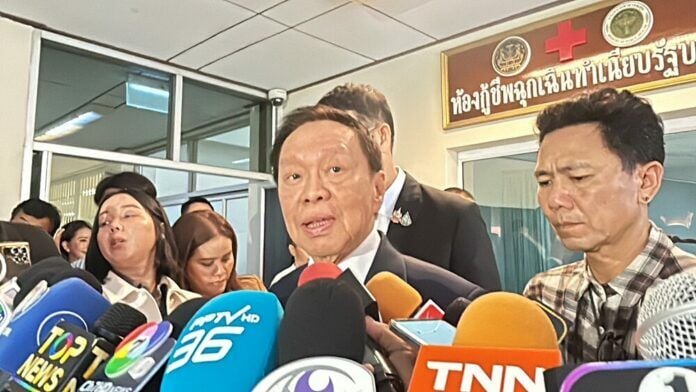Thailand govt to review Thap Lan National Park boundary

Thai Deputy Prime Minister and Minister of Natural Resources and Environment Patcharawat Wongsuwan addressed public concerns over the proposed boundary adjustments to Thap Lan National Park in Prachin Buri, Nakhon Ratchasima. Public opinion will be considered before final decisions are made by this Friday, July 12.
The issue currently undergoing public consultation has drawn mixed reactions, with some citizens voicing strong opposition. The consultation period is set to conclude on July 12, after which the Department of National Parks (DNP) will review the feedback and finalise actions within 30 days. Presently, villagers occupy approximately 50,000 rai of land out of a total of 260,000 rai in the area.
When questioned about public opposition, particularly concerns that the land reallocation could benefit private investors, Patcharawat assured that all opinions would be taken into account.
DNP Director-General Attapol Charoenchansa highlighted the historical context of the issue. Since 1981, the area has been a subject of contention. Initially a forest reserve, it was later designated as a national park, overlapping with lands allocated for agricultural use by local communities.
This overlap has been acknowledged as an oversight by the Royal Forest Department (RFD). Efforts to resolve this began in 2000 with a survey to redefine boundaries, but legal complexities have prolonged the situation.
Successive governments have attempted to address the issue, leading to a resolution by the National Land Policy Committee (NLPC) to reallocate community land under the supervision of the Agricultural Land Reform Office (ALRO). The Cabinet endorsed this resolution, except for landowners involved in legal disputes.
Attapol noted that the DNP is gathering public opinions both offline and online, which will then be presented to the National Park Committee for review within 30 days. The Committee aims to balance agricultural needs with forest conservation.
The discussion involves over 200,000 rai of land, including 12,000 rai occupied by resort groups under legal scrutiny. The focus is on how to manage these areas while considering the rights of original landowners. Attapol clarified that eligibility for land use will be determined by legal criteria, and the Committee will consider all feedback before reaching a final decision.
When asked if the Cabinet’s resolution on March 14 last year favoured private investors, Attapol responded that the government is working to ensure that land remains state-owned. Any use must meet legal qualifications and non-compliant land will revert to the state.
Further questions highlighted concerns about equal rights for original and new land occupants. Attapol explained that while the land status remains consistent, individual qualifications vary. Long-term residents and those who have recently purchased land will be assessed differently. Farmers using land for agriculture will be given priority in the reallocation process.
The DNP will wait for the National Park Committee’s recommendations before potentially proposing any changes to the existing Cabinet resolution. The focus remains on resolving long-standing land disputes while ensuring fair access and conservation of national park lands, reported KhaoSod.
ORIGINAL STORY: Thap Lan park risks losing 265,286 rai to land reform project
Thap Lan National Park faces the potential loss of 265,286 rai of forest land due to an agricultural land reform project, according to Chaiwat Limlikhitaksorn, National Park Office Director. Concerned about this significant reduction, he has called on the public to oppose the government’s move through an online poll organised by the Department of National Parks, Wildlife and Plant Conservation until July 12.
Thap Lan National Park, spanning roughly 1.4 million rai, covers four districts in Nakhon Ratchasima and one district in Prachin Buri. This park is a crucial part of the Dong Phayayen-Khao Yai Forest Complex, recognised as a World Heritage site.
On March 12 last year, the cabinet led by Prayut Chan-o-cha authorised the Ministry of Natural Resources and Environment to revoke the protected status of the land in question, allowing it to be used for Sor Por Kor land plots to resolve ongoing disputes between locals and the national park.
The redefined borders follow the government’s One Map project, which standardises maps at a scale of 1:4,000 to address issues of overlapping boundaries, said Chaiwat.
“People should be concerned if the national park’s borderline will be changed due to last year’s cabinet’s resolution. With the new borderline, the department will lose 265,286 rai to the Office of Agricultural Land Reform (OALR).”
The land, once transferred to farmers, can be sold after five years, a solution Chaiwat deems inappropriate for resolving land disputes. Thap Lan was designated a national park in 1981, three years after OALR announced land reform plans for the area, initially covering 58,882 rai. However, a new survey and the One Map project in 2016 expanded the disputed land to over 260,000 rai, particularly in Soeng Sang and Wang Nam Khieo districts, which are popular resort areas in Nakhon Ratchasima province.
Other regions
Chaiwat highlighted that those occupying the disputed land include not only landless farmers but also investors and resort owners seeking profit. The loss of forest reserves in Thap Lan could trigger similar demands in other regions.
There are 316,560 households on disputed land nationwide today. He remarked If the Thap Lan model succeeds, the country will lose about 4.2 rai of forest land to those who have encroached. This situation contradicts the 20-year national strategy, which mandates preserving 40% of the country’s land as natural forest.
Before the new borders are finalised, public opinion will be gathered. Chaiwat urged people to voice their concerns via the online poll available on Thap Lan National Park’s Facebook page (facebook.com/ThapLan.NP) until July 12. Additionally, public hearings will be held on Thursday and Friday in Nakhon Ratchasima, Prachin Buri, and Sa Kaeo.
The collected opinions will be forwarded to the national committee overseeing the park for further consideration, reported Bangkok Post.
Latest Thailand News
Follow The Thaiger on Google News:


























